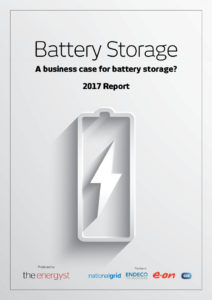Investors want to support battery storage, but there are significant challenges to negotiate. Brendan Coyne reports
As an enabler of greater renewables penetration, “storage is a key area that the bank is looking to support,” says Philip Bazin, environment team manager, Triodos Bank.

Triodos is therefore “keen to support the right type of projects for customers with medium to long-term outlooks in this space”, says Bazin. But the bank has “a relatively cautious appetite, because there are questions around risk, reward and bankability” of battery assets.
“Energy storage as an asset class is difficult to bank as low risk due to significant uncertainties that sit around the space,” he says.
Given the risk profile, “we have been trying to overcome the shortfall in the level of debt we could offer compared to the debt to equity ratios in some traditional asset classes,” adds Bazin.
The bank is looking at ‘bundling’ funding streams. Bazin uses a mortgage analogy to explain it.
“[With a mortgage] you might typically take a loan-to-value (LTV) range of 70-90%, depending on assets and locations. Similarly, that is what we would typically expect to lend to a project with a [traditional] renewables risk profile. They are well understood with long economic life, which is why banks feel comfortable with those LTVs,” he says.
“With energy storage, there is a much greater level of uncertainty around them, market and regulatory. So we have to take a pair of scissors to the assumptions, cut them down and you end up with very prudent projections of loans-to-value of senior debt that are relatively low, 40-60% at the very best,” Bazin continues.
Going through the “rigmarole” of engaging with the bank to get a LTV of 40-50% “may not be particularly attractive to an asset developer,” says Bazin. “So there is a challenge as to whether we can create a compelling enough service.
“Other forms of capital are prepared to take greater risk at a greater cost and we are trying to compete against different types of funding sources. So we have to bundle together different types of capital to provide an overall service that is more compelling compared to other funding sources available out there,” he says.
“That is the challenge for banks.”
Behind the meter
Bazin believes behind the meter (BTM) storage “makes a lot of sense”.
“Ultimately the key question [for us] is who is the customer, who is going to be using this asset? Behind the meter, a large I&C firm represents a much clearer answer to that key question … [and that] should be a natural home for energy storage solutions,” he says.
Others looking to deploy capital also view BTM storage as an opportunity. Ingenious Infrastructure expects substantial growth in the sector.
“We are focusing on behind the meter and collocation behind the meter. So private wire PPAs, together with batteries behind the meter, or just battery storage behind the meter for commercial and industrial customers”, says Roberto Castiglioni, senior investment director, Infrastructure and head of battery storage at Ingenious Group.
“We believe there is a big market out there, probably around 1GW within the next two to three years, just on the BTM side.”
Esco approach

Castiglioni says the market “has moved quite a lot” from in front to behind the meter since the firm started looking at batteries some 12 months ago.
“We always believed behind the meter was good, because we come from energy efficiency. So we understand how to manage relationships with customers behind the meter,” he says. “And we believe that adding a contracted, long-term revenue to the battery stacking system creates better visibility for an investor over the long-term.”
Castiglioni believes an Esco type approach makes storage projects more viable.
“We started from the issue of making the project bankable or investible. That is difficult when you are only relying on a short-term revenue stream,” he says.
“So if you add energy savings to the mix, you create long-term contracted revenue on the battery. On top of that you can do Capacity Market, which is 15-years. That leaves FFR, which is short-term, but at least you have created a bulk of long-term revenue that can amortise the full cost of the battery under the contract.”
Taking that approach, the firm is targeting a 150MW storage portfolio within the next two years. Castiglioni admits that is ambitious and that engaging customers will be critical.
“Doing business with customers is not straightforward. We have experience with energy efficiency so we understand how complex it is. It is not like building a solar park, which, once you have planning and connection, is easy to do,” he says.
“But people are getting up to speed and they know batteries can benefit their business and give them an edge – because if you have lower opex, it is money you can put somewhere else in your operation.”
Managing risk
Ambitious targets suggest Ingenious has faith that its business model will attract customers and that it can overcome issues around certainty and visibility of revenue. Castiglioni accepts that FFR prices may fall markedly, as some predict, but suggests that risk is counterbalanced by market fundamentals.
“We are comfortable that the need for battery will still be there,” he says.
“The more intermittent renewable generation that is put onto the grid, the more batteries we need. The more that older generation comes off the system, the more batteries are needed on the grid.
“So, we take comfort from the fact that there will be a need for battery storage. But also from the high flexibility of the asset itself; it can chase different revenues and do different things. Unlike a solar plant, where if you kill the subsidies you kill the project, the battery can actually chase different revenues,” says Castiglioni.
“So we know things will change, but we are confident that the battery will be flexible enough.”
Technical risk
Castiglioni takes a similarly pragmatic view on technical risk around potential asset degredation as a result of performing multiple services.
“Warranties are important [and] more importantly, who’s providing them. We will operate with suppliers that are going to be there for us in the long run. Experience says that things can go wrong, so we are focusing on top tier suppliers.”
Castiglioni says credible suppliers will tackle problems should they emerge.
“The worst-case scenario is that in year ten, you start putting in some new cells, maybe second life, maybe new technology,” he says.
“The technology is moving so quickly. The revenue stream is changing. There are so many variables that it is impossible to model all of the potential scenarios that may arise.
“Ultimately we need to take comfort from the underlying asset.”
Niche market?
While Ingenious perceives a growth opportunity for its business, Triodos Bank’s Philip Bazin believes the market may end up being relatively small, compared to the renewables sector.
“We can see a longer-term demand; the question is how much demand, how much supply and what are the barriers to entry. At the moment, there are simply a lot of unknowns,” he says.
“Banks don’t like uncertainty. They won’t lend against too much uncertainty. We do underwrite risk, but not at the quantum of where the market is currently sitting.”
While emerging opportunities enabled by batteries such as arbitrage are “interesting”, Bazin describes that revenue stream as “cream, rather than anything else”. Similarly, he says voltage control is “very interesting… but still rather technical, complex and uncertain.
“It’s a very interesting market, but it is going to be quite a niche market for a little while. There seems to be too many people looking at what is going to be quite niche, in gigawatt terms, relative to the many gigawatts of installed renewables,” says Bazin.
“Look at the volume of [connections] applications; how much has gone into planning. Yet in the near term we are perhaps only talking about one, two or three gigawatts of additional storage capacity.”
Mass market?
Jason Hunter, associate director of Capitas Finance’s energy efficiency division, believes there’s “a very solid business case” for behind the meter storage at industrial and commercial sites. “I think that’s where the growth is,” he says, driven by increasing non-commodity costs “of which there is clear visibility”.
That helps to mitigate risk, says Hunter, and is a persuasive argument for industrial and commercial companies.
While both network charging structures and frequency products may change, Hunter believes increasing volume of renewables, loss of thermal plant and inertia, creates an ongoing requirement for batteries.
“We are comfortable in this sector, because we know there are so many applications for storage systems,” he says. “Regulation and markets may change but taking out gigawatts of coal and gas and adding gigawatts of wind and solar will only increase demand for voltage and frequency response services.”
Regulatory risk
Ofgem has not yet made clear its intentions for behind the meter storage as part of a broader review of charging regimes.
That is “a bit of a concern”, says Ingenious Infrastructure’s Castiglioni.
“The issue is not having visibility. We are working on something today that will change tomorrow. Any time you don’t have visibility over your cash flow there is a concern. And we know that they may reduce our revenue stream,” he says. “That would be okay if they increased the visibility of the cash flow.”
Triodos Bank’s Philip Bazin agrees, caveating his belief in BTM at industrial sites as “making sense” for storage by admitting, “these are based on current charging regimes and it is difficult to know what they look like going forward.”
However, Bazin believes “all of the right questions are being asked now, so hopefully in the next two to three years we will get to a more stable regulatory framework to enable better investment decisions to be made”.
 This article is taken from The Energyst’s latest Battery Storage report. The report also contains the views of public and private sector end users considering storage, energy consultants, energy companies and aggregators.
This article is taken from The Energyst’s latest Battery Storage report. The report also contains the views of public and private sector end users considering storage, energy consultants, energy companies and aggregators.
Thanks to sponsors Endeco, Eon and National Grid, it’s available as a free download here.
Related stories:
Shifting the balance of power: New, free demand-side response report
Energy storage ‘will wipe out’ battery storage
Battery storage to push frequency response revenues down STOR’s path?
National Grid confirms cull of frequency response products
Aurora: Battery storage, DSR and peaking plant to hit 25GW
Marks & Spencer mulls battery storage investment
Centrica to use council’s 3MW battery storage unit to balance local and national grids
Centrica: Floodgates on battery storage investment to open in 2017
Battery storage: Finance a challenge but businesses predict 3-7 year paybacks
As solar generation makes history, National Grid starts to feel the burn
UK Power Networks receives 12GW of storage applications
Limejump and Anesco partner to connect 185MW of capacity market battery storage
UK Power Networks outlines smart grid plans
UKPN sees battery boom, outlines DSR plans
Government sets out smart grid vision
National Grid adds 500MW of flexibility in 2016, more to come
As solar subsidies wane, investors plan 2.3GW of battery storage projects
Vattenfall to build 22MW battery storage plant at south Wales windfarm
VLC Energy to connect 50MW of battery storage in 2017 after EFR contract win
Greg Clark calls for carmakers and energy firms to deliver battery storage
More than half of I&C firms mulling energy storage investment
Capacity market too low for large gas, but gigawatts of DSR, batteries and CHP win contracts
Battery storage: positive outlook?
National Grid must provide a plan for battery market, says SmartestEnergy
Who needs an EFR contract? Somerset solar site installs ‘grid scale’ Tesla battery
Ofgem: Energy flexibility will become more valuable than energy efficiency
National Grid says UK will miss 2020 targets, predicts big battery future
Nissan: Carmaker signals roadmap to energy services company
Flexitricity chief: UK has enough spare power electrify every car on the road
Government finds £20m for vehicle to grid development
Shifting the balance of power: New, free demand-side response report
Follow us at @EnergystMedia. For regular bulletins, sign up for the free newsletter.



